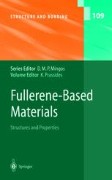Search
Search Results
-
Non-covalent Immobilization of Catalysts Based on Chiral Diazaligands
The immobilization of chiral catalysts through non-covalent methods, as opposed to covalent immobilization, allows an easier preparation of chiral...
-
New Phosphorylated Hosts for the Design of New Supramolecular Assemblies
Development of chemistry around new phosphorylated hosts provides an interesting new area of investigations in the design of host-guest systems....
-
Electrochemistry and Electrogenerated Chemiluminescence of Semiconductor Nanocrystals in Solutions and in Films
A retrospective overview of electrochemical studies of semiconductor nanocrystals (NCs) is given. The electrochemical behavior of monodisperse NCs...
-
Probing Hydrogen Bonding in Solids Using Solid State NMR Spectroscopy
Solid state nuclear magnetic resonance (NMR) spectroscopy is a powerful and versatile technique for probing structural and dynamic properties of...
-

-
Structural and Electronic Properties of Selected Fulleride Salts
The study of strongly correlated electron systems is at the forefront of contemporary condensed matter research because such materials, which include...
-
Ligand-Driven Light-Induced Spin Change (LD-LISC): A Promising Photomagnetic Effect
“Ligand-driven light-induced spin change” (LD-LISC) is a photomagnetic effect based on the modulation of the ligand-field strength of a suitable...
-
Valence Tautomeric Transition Metal Complexes
Valence d-orbital energies of the first row transition metals are close to the frontier π-orbital energies of o-benzoquinones. Complexes prepared...
-
Structural Aspects of Spin Crossover. Example of the [FeIILn(NCS)2] Complexes
The interplay between the spin crossover and the structural properties of the complexes in the solid state is still under investigation. In...
-
Cycloaddition Reactions of Group 6 Fischer Carbene Complexes
Group 6 heteroatom-stabilised carbene complexes (Fischer carbene complexes) offer many interesting possibilities to build rings (carbocycles and...
-
Photoinduced Reactions of Metal Carbenes in Organic Synthesis
The photoinduced reactions of metal carbene complexes, particularly Group 6 Fischer carbenes, are comprehensively presented in this chapter with a...
-
Thio-, Seleno-, and Telluro-Carboxylic Acid Esters
This chapter reviews studies into the preparation of thio-, seleno-, and telluro-carboxylic acid esters (referred to thiol, selenol, and tellurol...
-
Nanoscale Lattice Fluctuations in Cuprates and Manganites
Local lattice displacements giving a nanoscale inhomogeneous pattern due to mesoscopic phase separation in the correlated transition metal...
-
Essential Heterogeneities in Hole-Doped Cuprate Superconductors
An expanded review of recent pertinent experiments in hole-doped cuprates is presented [1]. These include photoemission, inelastic neutron...
-
The Construction and Operation of Anion Sensors: Current Status and Future Perspectives
This chapter is intended to provide an insight into the construction and operation of anion sensing devices, rather than the chemistry of anion...
-
Palladium-Catalyzed Cross-Coupling Reactions of Unactivated Alkyl Electrophiles with Organometallic Compounds
For many years, unactivated alkyl electrophiles that contain β hydrogens were generally regarded as unsuitable partners for palladium-catalyzed...
-

-
Macrocycle Synthesis Through Templation
This review highlights the major advances over the last 5 years in the templated synthesis of carbon-based macrocycles. With selected examples, it...
-
Recent Advances in the Chemistry of Difunctionalized Organo-Phosphorus and -Sulfur Compounds
Recent results related to the synthesis and reactivity of organocompounds substituted by both phosphorus and sulfur functional groups are reviewed....
-
Donor-Acceptor Complexes of Low-Coordinated Cationic π-Bonded Phosphorus Systems
Cationic low-coordinated π-bonded phosphorus compounds add Lewis donors, such as amines or phosphines. In contrast to the trigonal bipyramide formed...
